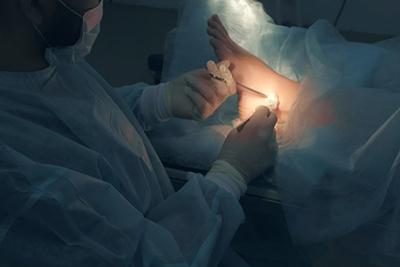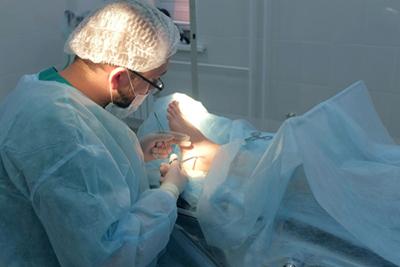
-
Foot Surgery: What To Expect
posted: Mar. 11, 2024.

-
What To Know About Foot Surgery
posted: Oct. 06, 2023.

-
What To Expect During Foot Surgery
posted: Oct. 02, 2023.

-
Treating Your Heel Pain
posted: Aug. 01, 2023.
Heel pain can significantly impact mobility and quality of life. Common symptoms include sharp or dull pain beneath the heel, especially when taking the first steps in the morning or Read more -
Important Questions for Your Foot Doctor
posted: Mar. 08, 2023.
Foot doctors are also called podiatrists and specialize in treating injuries, conditions, and symptoms affecting the feet and ankles. Whether you have bunions, a sprained ankle, or a condition such Read more -
When Should You See Someone for Heel Pain?
posted: Feb. 27, 2023.
Heel pain is a real pain in the foot. It's that annoying, nagging discomfort you feel with each step you take, and it can put a damper on your daily Read more -
When To See a Podiatrist
posted: Dec. 08, 2022.
If you have pain in your feet, you can trust Dr. Barry Finkelstein of the NYNJ Foot and Ankle Associates as your podiatrist in Bronx, NY, for the best diagnosis, Read more -
When is Foot Surgery Needed?
posted: Nov. 08, 2022.
Certain types of foot pain can really impact your life and cause you irritation and might make you miss your favorite activities. If you’ve tried conservative methods of treating a Read more -
Questions To Ask Your Podiatrist
posted: Oct. 21, 2022.
It is hard to perform the activities of daily life if you are suffering from pain in your feet or ankles. If you have questions for a podiatrist in the Read more -
When To See A Podiatrist
posted: Jun. 28, 2022.
The health of your feet is very important to your overall health. A problem involving your foot can cause incapacitation for weeks. As soon as you become aware of a Read more -
Why Do I Have Heel Pain?
posted: Apr. 12, 2022.
Have you recently developed heel pain? Your Bronx, NY, podiatrist, Dr. Barry Finkelstein of NYNJ Foot and Ankle Associates, offers treatments designed to treat the source of your problem and Read more -
The Importance of Having a Foot Doctor
posted: Feb. 22, 2022.
Have you seen your Bronx, NY, foot doctor, Dr. Barry Finkelstein of NYNJ Foot and Ankle Associates recently? A visit with the podiatrist is the perfect way to protect your Read more -
Don’t Ignore Your Heel Pain
posted: Feb. 07, 2022.
If you’re experiencing heel pain, especially after long periods of rest, don’t wait to get help. Visit Dr. Finkelstein at NYNJ Foot and Ankle Associates in Bronx, NY. Why Does My Read more -
When is Foot Surgery Needed?
posted: Dec. 16, 2021.
There are a number of conditions that can be improved through foot surgery by your Bronx, NY, podiatrist. Surgery is sometimes necessary to restore your mobility and to relieve you Read more -
What Are Bunions?
posted: Sep. 20, 2021.
Unfortunately, bunions are often a pain. Sometimes, they are a serious problem. A bunion, which is also known as a hallux valgus, is a large bony bump near your big Read more -
Foot Surgery For Plantar Fasciitis
posted: Sep. 14, 2021.
If you live with chronic pain due to plantar fasciitis, foot surgery may be a viable option in Bronx, NY. Visit Dr. Barry Finkelstein of NYNJ Foot and Ankle Associates for treatment options. What is Read more
Contact Us
Send Us an Email
Our Location
Find us on the map
Hours of Operation
Our Regular Schedule
NYNJ Foot and Ankle Associates
Monday:
9:00 am-5:00 pm
Tuesday:
9:00 am-5:00 pm
Wednesday:
9:00 am-5:00 pm
Thursday:
9:00 am-5:00 pm
Friday:
9:00 am-5:00 pm
Saturday:
Closed
Sunday:
Closed